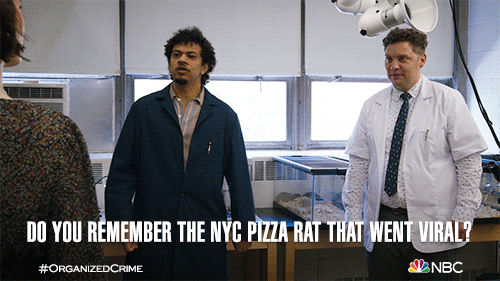Viral GIFs have taken the internet by storm, becoming an essential form of communication in our digital lives. These looping animations are not just entertaining; they convey emotions, reactions, and even entire conversations in a matter of seconds. But where did this phenomenon begin? Let’s dive into the origins and explore why these quirky little images resonate so deeply with us.
The Impact of "Are You Ready to Rumble?" on Internet Culture

One of the most iconic phrases to emerge from the world of viral GIFs is "Are You Ready to Rumble?" This line, famously uttered by boxing announcer Michael Buffer, has transcended its original context to become a staple in online culture. But what makes this phrase and its associated GIF so impactful?
1. The Power of Catchphrases
Catchphrases have a unique ability to stick in our minds. "Are You Ready to Rumble?" encapsulates excitement and anticipation, making it perfect for use in various situations, from gaming to sports events. The GIF of Buffer announcing this phrase often pops up in contexts like:
- Before a big game or match
- When preparing for a challenge or competition
- In reaction to thrilling news or events
2. Meme Evolution
As internet users began sharing this GIF across social media platforms, it morphed into something more than just a nostalgic reference. It became a meme, with users creatively repurposing the GIF to fit different narratives. For instance:
- Gaming Memes: Players use the GIF before epic battles.
- Event Reminders: Friends share it in group chats to hype each other up.
3. Cultural Significance
The widespread use of this GIF signifies a shift in how we communicate. Instead of lengthy explanations, we can convey complex feelings and hype with just a single image. This shift reflects broader changes in our attention spans and the way we consume media. The GIF encapsulates a moment, bringing a sense of nostalgia while also generating excitement for the future.
4. GIFs as Art
In the realm of digital art, GIFs are gaining recognition. Artists have started to create intricate GIFs that tell stories or evoke emotions. The "Are You Ready to Rumble?" GIF serves as a reminder that even simple animations can have profound cultural implications and artistic value. It opens the door for discussions about what constitutes art in the digital age.
In conclusion, the impact of "Are You Ready to Rumble?" transcends its original context, demonstrating the power of GIFs in shaping internet culture. As we continue to embrace these looping animations, we can expect new phrases and moments to emerge, each adding to the rich tapestry of our digital conversations.
Also Read This: Are There NPCs in Team Rumble Mode in Fortnite?
3. Exploring the Origins of the GIF

The Graphics Interchange Format, or GIF, was developed in 1987 by a team at CompuServe led by Steve Wilhite. The initial goal was simple: to create a format that could easily transmit images over the slow dial-up connections of the time. Imagine trying to send a colorful picture while everyone else was still waiting for those pixelated images to load—frustrating, right?
The GIF format was revolutionary because it allowed for lossless compression, meaning that images could be compressed without losing quality. This was particularly important for the limited bandwidth of the late '80s. Wilhite and his team used a technique called Lempel-Ziv-Welch (LZW) compression, which allowed for smaller file sizes. This enabled users to share images quickly, which was a game-changer in the early days of the internet.
But why stop at static images? In 1989, the GIF89a version was released, introducing support for animations. This meant that multiple images could be displayed in a sequence, creating the first animated GIFs. These early animated GIFs were often simple and utilized limited color palettes, but they captured the imagination of users and set the stage for what was to come.
Fast forward to the 2000s, and the GIF began to experience a renaissance. As broadband internet became more widely available, sharing GIFs became easier than ever. Websites like Giphy emerged, allowing users to create, share, and search for GIFs. This platform helped to solidify GIFs as a form of visual communication, leading to their widespread use in social media and messaging apps.
So, what made GIFs so popular? It’s all about their ability to convey emotion and reactions in a way that static images simply can’t. Whether it’s a funny cat video, a perplexed reaction GIF, or a nostalgic scene from a beloved TV show, GIFs can encapsulate a moment and share it instantly. This unique capability is what turned the humble GIF into a cultural phenomenon.
Also Read This: How to Build Rumble and Customize Your Character for Maximum Strength
4. Memes and Their Evolution: From GIFs to Mainstream Media
Meme culture has exploded in the digital age, and GIFs play a pivotal role in that evolution. Initially, memes were simple text-based images shared across forums and social networks. However, as technology advanced and social media platforms evolved, the way we interacted with memes began to change dramatically.
GIFs have become a powerful medium for memes, allowing users to express emotions and reactions more vividly. Here’s how the journey unfolded:
- Early Days: Simple image memes like "Bad Luck Brian" and "Success Kid" paved the way for more complex forms of expression.
- The Rise of GIFs: With platforms like Tumblr and Reddit, GIFs allowed for quick, humorous snippets that could be shared widely. They became the foundation of many viral memes.
- Integration into Social Media: Twitter, Facebook, and Instagram began supporting GIFs, making them more accessible. Users could now quickly insert a relevant GIF into their posts or comments.
- Brand Involvement: As GIFs gained popularity, brands started leveraging them in marketing campaigns, further blurring the lines between user-generated content and corporate messaging.
Today, memes have transcended their online origins and entered mainstream media. Shows like "Saturday Night Live" and "The Tonight Show" frequently reference popular GIFs or memes, showcasing their impact on popular culture. The evolution of memes reflects a shift in communication styles, where humor and relatability reign supreme.
In essence, GIFs are more than just a form of entertainment; they are a dynamic way of sharing culture, emotions, and ideas. As we continue to engage with digital content, it’s clear that the GIF phenomenon is here to stay, shaping the way we communicate in the modern age.
Also Read This: Why Can I Make a Rumbling Sound in My Ears
5. Why This GIF Became a Cultural Touchstone
The rise of the viral GIF phenomenon can be attributed to several key factors that have woven certain GIFs into the fabric of online culture. One of the most significant reasons is relatability. GIFs like the iconic "Distracted Boyfriend" perfectly encapsulate emotions and scenarios that many people experience, making them instantly recognizable and widely shareable.
Another factor is the humor embedded in many GIFs. Take the "Woman Yelling at a Cat" GIF, for example. It combines an intense emotional reaction with a completely oblivious cat, creating a hilarious juxtaposition that resonates with countless situations in everyday life. This blend of humor and relatability makes these GIFs not just fun to share, but also easy to use in various contexts, from serious discussions to light-hearted banter.
Furthermore, the timing and context in which a GIF is shared often elevate its status. For instance, during significant cultural events—like the Oscars or major sports games—GIFs capturing those moments quickly spread like wildfire. The GIF of Leonardo DiCaprio’s reaction at the Oscars went viral not just because of the moment itself, but because it was shared during a time of collective viewing and discussion, making it a cultural touchstone.
Also, the accessibility of GIF creation and sharing platforms plays a significant role. Websites like Giphy and Tenor allow anyone to upload or create their GIFs with ease. This democratization of content creation enables trends to emerge and evolve rapidly, as users remix and adapt popular GIFs to fit new contexts or jokes.
Lastly, the element of community cannot be overlooked. Whether it’s within niche forums, Twitter threads, or even group chats, the shared experience of creating, using, and laughing at GIFs fosters a sense of connection among users. This communal aspect is what transforms a simple image into a viral phenomenon, as it becomes a shared language that transcends barriers and brings people together.
6. How to Create and Share Your Own Viral GIFs
Creating your own viral GIF can be an exciting venture! Whether you’re looking to capture a funny moment or share a relatable reaction, the process is surprisingly simple. Here’s a step-by-step guide to help you get started:
- Choose Your Source Material: Start with a video clip that has potential. It could be something from a movie, a television show, or even a personal video. The key is to find a moment that’s funny, dramatic, or highly relatable.
- Use a GIF Maker: There are several online tools available for creating GIFs. Websites like Giphy and Imgflip allow you to upload your video or provide a link. Simply follow their instructions to select the segment you want to turn into a GIF.
- Add Text or Effects: Most GIF-making platforms let you overlay text or add effects. This is where you can infuse your personality or add a punchline. Think about what would make your GIF more engaging or relatable. For example, adding a witty caption can enhance the humor.
- Export and Save: Once you’re happy with your creation, export it! Make sure to save it in a format that works for sharing online—GIF files are usually ideal.
- Share Your GIF: Time to put your creation out into the world! You can share it on social media platforms like Twitter, Instagram, or Facebook. Tag your GIF appropriately to reach a wider audience, or submit it to GIF platforms like Giphy for even more visibility.
Remember, the essence of creating a viral GIF lies not just in the content itself, but in how it resonates with others. Keep experimenting, and don’t be afraid to tap into current trends or memes. Who knows? Your GIF could be the next big thing!
 admin
admin








